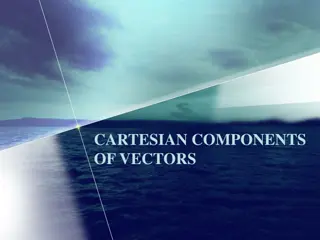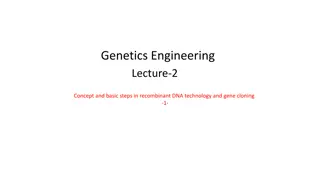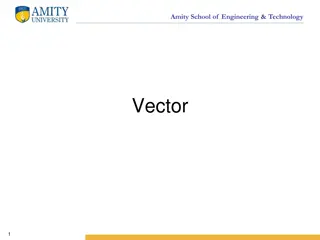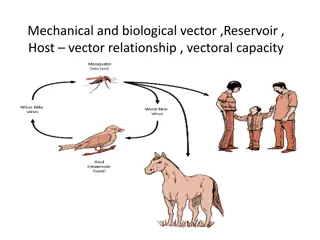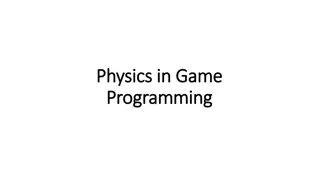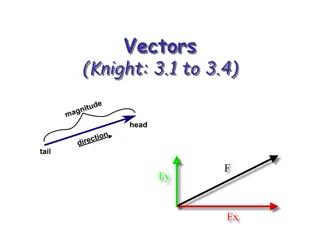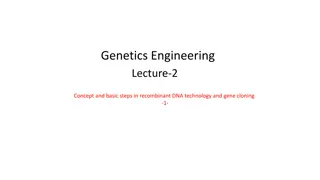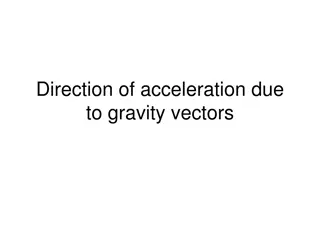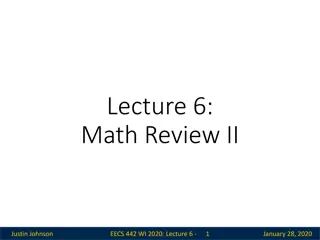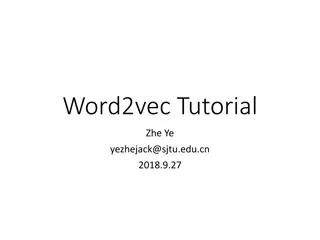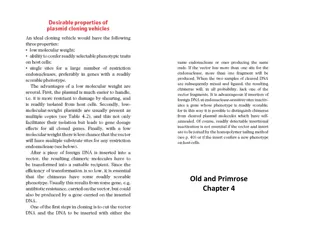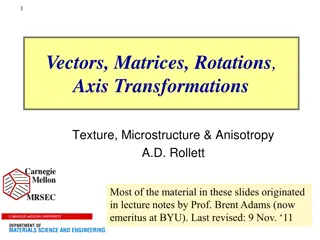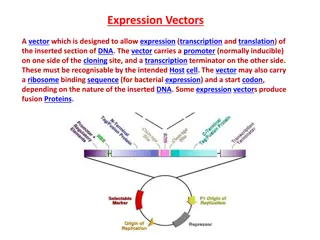Understanding Four-Vectors in 4D Space
Explore the concept of four-vectors in four-dimensional space, covering topics such as radius vectors, general 4-vectors, contravariant and covariant components, summation conventions, scalar products, and the components of a general 4-vector. Learn how these vectors transform under rotations and Lorentz transformations, and understand the distinction between time-like, space-like, and null vectors in 4D. Dive into how 4-vectors relate to 3D vectors and scalars, and their behavior under ordinary 3D space rotations.
Download Presentation

Please find below an Image/Link to download the presentation.
The content on the website is provided AS IS for your information and personal use only. It may not be sold, licensed, or shared on other websites without obtaining consent from the author. Download presentation by click this link. If you encounter any issues during the download, it is possible that the publisher has removed the file from their server.
E N D
Presentation Transcript
Section 6 Four vectors
1. Four-radius vector Coordinates of an event in 4-space are (ct,x,y,z). Radius vector in 4-space = 4-radius vector. Square of the length (interval) does not change under any rotations of 4 space.
2. General 4-vector. Any set of four quantities (A0,A1,A2,A3) that transform like (x0, x1, x2, x3) under all transformations of 4 space, including Lorentz transformations, is called a four-vector. Lorentz transformation of Ai Square magnitude of Ai
Two types of 4-vector components Contravariant: Covariant: Ai Ai with superscript index with subscript index Lorentz transform contravariant components Lorentz transform covariant components Square of four vector =
3. Summation convention: Summation is assumed if indices are repeated AND one is subscript while other is superscript. Such repeated indices are called dummy indices. 4. Latin letters are reserved for 4-D indices. Greek letters are reserved for 3-D indices.
5. Scalar Product of two different four vectors We can switch upper and lower indices in any pair of dummy indices: Ai Bi = Ai Bi We can rename them: Ai Bi = Ak Bk
6. Scalar Product Ai Bi is a four-scalar. 4-scalars are invariant under rotations in 4D. The interval is a 4-scalar.
7. The components of a general 4-vector have either time or space character A0is the time component A1, A2, A3are space components If square of A = AiAi is >0, then A is time like <0, then A is space like =0, then A is a null vector or isotropic
8. Under ordinary 3D space rotations, the three space-like components of a 4-vector transform like a 3D vector A, and the time component transforms like a 3D scalar. A 4-vector is often written as For 3D vectors, no distinction between covariant and contravariant
9. A four-tensor of rank 2 is a set of sixteen quantities Aik that transform like products of two four vectors For example, A12 transforms like x1x2 = xy
10. Three forms for second rank tensors: Contravariant: Aik Covariant: Aik Mixed: Aik and Aik Be careful, these two are not generally the same thing. Raising or lowering an index 1,2,3 changes sign of component Raising or lowering the index 0 does not.
11.Tensor subparts have 3D meanings under purely spatial transformations E.g. under 3D rotation,
12. Some special tensors in Electrodynamics have a particular symmetry Symmetric tensors Antisymmetric tensors Diagonal elements of antisymmetric tensors are zero, since we must have
13. Rules for tensor equations (E.g. Maxwell s equations will be written as a pair of tensor equations.) The two sides of every tensor equation must contain identical, and identically placed, free indices. Shifting of free indices must be done simultaneously on both sides. Pairs of dummy indices can be renamed or raised/lowered anytime. Which are the free indices in each of these examples? Which is a proper tensor equation? = Clk = Clk = Clk
14. Contraction From tensor Aik, we can form a scalar by contraction: Aii= the trace of Aik
15. The scalar product Ai Bi is a contraction of the tensor Ai Bk Contraction lowers rank of tensor by 2
16. Some special tensors are the same in all coordinate systems by definition Unit 4-tensor Trace
17. Metric tensor, obtained by raising or lowering one index of unit tensor, taking into account the sign change for the space components. (Components are the same in all coordinate systems) Column index, in order 0,1,2,3 Row index We can lower the same index on both sides We hardly use the metric tensor at all in ED1, but in generalrelativity it s the Main Event.
18. Completely antisymmetric unit tensor of 4th rank eiklm. Components = 1 or 0. (Same in all coordinate systems by definition) Antisymmetry: Components change sign under interchange of any pair of indices. All components with any two indices the same are zero. e0123 = +1 and e0123 = -1 Other non-zero components of eiklm = 1, depending on whether an even or odd number of permutations bring iklm to 0123. The number of permutations is 4! = 24. eiklmeiklm = -24, ( - because covariant component is always opposite of the contravariant one.)
19. eiklm is a pseudo tensor Under rotations of 4-space (Lorentz transformations) eiklm behaves like a 4- tensor. But under inversions and reflections (change of sign of one or more coordinates) it does not. By definition eiklm is invariant under any transformation, but components of a true rank-4 tensor (e.g. xixkxlxm) with all indices different change sign when one or 3 coordinates change sign. Pseudo tensors, including pseudo scalars, behave like tensors for all coordinate transforms except those that cannot be reduced to rotations (e.g. reflections)
20. Other invariant true tensors: Is a rank 8 true tensor Rank 6,4,2 tensors are obtained by contracting on one or more pairs of indices All are invariant under coordinate transformations: They formed from products of components of unit tensor.
21. Dual of an antisymmetric tensor Aik Dual of the 4-vector Ai An example of a dual relationship is that between a 2D area element and the normal vector with magnitude equal to the area.
Product of dual tensors True scalars are invariant under ALL possible symmetry operations Two tensors that are dual have the same components, but differently arranged.
22. 3D vectors and tensors Completely antisymmetric unit pseudo tensor of rank 3 We use this ALL THE TIMEto derive vector identities. Levi-Civita method.
24. Inversion of coordinates Components of ordinary vector change sign (polar) e.g. position vector r Components of cross product of two polar vectors do not (axial) e.g. torque = r x F Scalar product of polar and axial vector is a pseudo scalar An axial vector is a pseudo vector dual to some antisymmetric tensor.
25. Antisymmetric 4-tensor Aik Space components (i,k, = 1,2,3) form a 3-D antisymmetric tensor with respect to spatial transforms. By dual relationship, the components are expressed in terms of 3-D axial vector. e.g. A12 transforms like 3rd component of an axial vector by dual relationship. Components A01, A02, A03, form a 3-D polar vector with respect to spatial transforms. e.g. A01 tranforms like tx, which changes sign on spatial inversion. Where p and a are polar and axial vectors with respect to spatial transforms
26. Tensor Calculus Differential operations
27. 4-gradient of a scalar function of space and time: = (x0, x1, x2, x3) Must be a 4-scalar on both sides Is a covariant 4-vector Even though xi is contravariant
29. Tensor calculus, Integral operations. In 3D, we have 3 types of integrals Line Surface Volume In 4D, there are 4 types Curve in 4-space 2D surface Hypersurface (3D manifold) 4D volume
30. Integral over a curve in 4-space The infinitesimal line element is a 4-vector: dxi
31. Integral over 2D surface First review 3D. Surface area element in 3D The projections of the area of a parallelogram on the coordinate planes are which is an antisymmetric rank 2 tensor The vector is normal to the surface element and equal in absolute magnitude
Integral over 2D surface in 4D The infinitesimal surface area element is a rank 2 antisymmetric tensor, whose components are the projection of the area element onto the coordinate planes. 16 components. Only 12 are non-zero. Only 6 are unique, corresponding to the 6 planes in 4 space. Its dual normal to dfik. describes a surface element that is equal in area and All segments in df*ik are orthogonal to all segments in dfik: df*ik dfik = 0.
32. Integral over a hypersurface (3D manifold) In 3D, the volume of a parallelpiped spanned by 3 vectors is a determinant
In 4D, the area elements of hypersurface are 3D volumes of parallelepipeds spanned by three 4-vectors dxi, dx i, and dx i A rank 3 tensor that is antisymmetric in all 3 indices What two properties of determinants show that the tensor must be an antisymmetric one?
A more convenient integration element is the 4-vector which is dual to the hypersurface area element Projection of hypersurface element on the hyperplane x0 = constant. (This hyperplane is all of 3D space at a given time.) A hypersurface area element described as a normal vector in the direction of the time axis
33. Integral over 4D volume 4D volume element is a 4-scalar.
4D Gauss theorem Integral over closed hypersurface transforms to an integral over the 4- volume inside by the replacement
An integral over a 2D surface transforms to an integral over the hypersurface spanning it by the replacement
4D Stokes Theorem The integral over a 4D closed curve tranforms to an integral over the surface than spans the curve via the replacement




